|
Hams | Raw Hams | Specialty Ham | Miscellaneous
|
Hams
Hams are cuts of pork that come from the leg, which have been dry cured (country hams) or wet-cured (city hams) and then boiled or smoked. The dry-cured hams are saltier, stronger flavored and have a coarser texture than the wet-cured hams. Hams are larger cuts, which are used to serve several people. A whole ham can weigh 10 lbs. to 20 lbs. or more, but are generally sold in halves. They are fairly low in fat but high in sodium and are available bone-in, semi-boneless or boneless. There are many different varieties that are cured and smoked using different methods. Also available are some miscellaneous products made from ham. Shown below are some of the different varieties of ham and ham products that are available. |
|
Whole Ham
 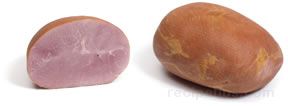
A processed cut which includes both the butt ham and shank ham from the leg. Whole hams can weigh from 10 lbs. to 20 lbs. or more. They are available bone-in and boneless. |
|
Butt Ham
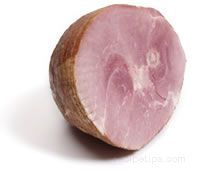 
A processed cut taken from the top half of the leg. The butt end is meatier but contains more fat than the shank end of the whole ham and is harder to carve because it contains the hip and pelvic bone. |
|
Shank Ham
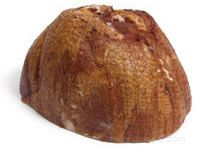 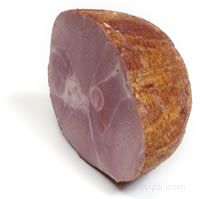
A processed cut taken from the bottom half of the leg. The shank end contains less fat, is not as meaty as the butt end, but it contains only one leg bone, making it easier to carve. It has a slightly sweeter flavor. |
|
Spiral Sliced Ham
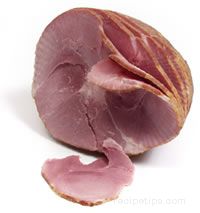
|
A precooked ham that has been pre-sliced in a spiral cut for your convenience. A spiral cut is a cut that is done in one continuous cut around the ham, starting at one end, and moving consistently to the opposite end to create the same thickness of slices throughout. Spiral slice ham should be used in 4 to 5 days or should be frozen because the pre-sliced pieces have a tendency to dry out faster. Dry-cured hams are generally not spiral sliced because the slices would not be cut thin enough and would dry out too fast. |
|
Center Ham Slice
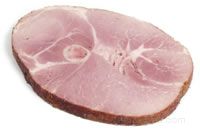
|
Also referred to as center cut ham steak, this cut is approximately ½ to 1 inch thick and is sliced from the center of the leg primal cut. It is available as a fresh cut of meat or it can be cured and smoked. The ham center slice may be found boneless or with a small circular bone included. It can also be found fully cooked and ready to serve. |
|
Raw Ham
Uncooked, dry-cured hams that are processed with the intention of the meat to be eaten raw. The salt used in the curing process draws out the moisture in the ham as it is hung to age. The hams go through a natural air curing process where they are exposed to cool, dry air. The air curing evaporates the moisture as it is drawn out of the meat, resulting in preservation of the ham through dehydration. During the curing process the ham may go through several pressings. These raw hams are generally slice thin and eaten raw. The meat should be allowed to sit at room temperature for 10 to 15 minutes, before eating, to allow it to develop its full flavor. Shown below are some of the most commonly known varieties of raw ham. |
|
Ardennes Ham |
An air-dried, salt cured, uncooked ham from Belgium, which is sliced thinly and served raw. It has an appearance and flavor that is similar to Italian prosciutto ham. If sliced thicker, it can be pan-fried. |
| Bayonne Ham |
A wine cured, boneless ham that is produced near the town of Bayonne, France. It is air-dried and lightly smoked ham with a flavor that is influenced by the wine used in the curing process. It is served and eaten similar to prosciutto only sliced slightly thicker. |
|
Black Forest Ham 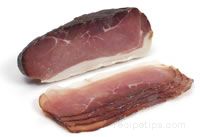 |
A moist German ham that is air-dried, salt cured and smoked over pine and/or fir to give it an intense flavor. To be a true Black Forest ham it must be produced in the Black Forest of Germany. It was traditionally coated with beef blood, which gave it a black exterior surface. Now, more commonly, the blackened exterior is the result of the spices applied and the smoking process. Black Forest ham is used in pasta dishes to add an intense flavor or sliced thin and served with cheeses and breads. |
|
Capocolla

|
An Italian ham made from boneless pork shoulder butt. It is mildly dry cured and seasoned with hot or sweet peppers, as well as salt and sugar. It is stuffed into a natural casing and air-dried. |
| Ham Capocolla |
Ham capocolla is made from the ham rather than the pork shoulder butt, which capocolla is made from. It is processed in the same manner as capocolla. |
|
Coppa

|
An Italian ham product that has been made from the pork shoulder and neck portion of the hog rather than from the hind leg. It has been salted, seasoned and dry cured for a long period. It is pressed into a skin, which produces a cylindrical shape. When sliced it is red in color with fat running through it. It is contains more fat than prosciutto and is less expensive. It has a mild aroma and sweet flavor. |
Culatello Ham
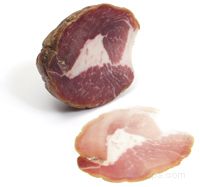 |
An expensive dry-cured Italian ham that is hard to find in the United States. It is made from the butt end, high up on the hind leg. It is cured with salt, pepper, garlic, and dry wine. It does not contain as much fat as prosciutto and is spicier. It is ruby red in color, has a strong aroma and a mild but sweet flavor. It is served in very thin slices. |
|
Jamon Serrano Ham
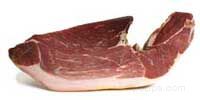 |
A dry-cured Spanish ham that comes from white hogs, which are raised in southern Spain and fed a diet of acorns. The ham is cured in a cool, high altitude and aged for at least 9 months. The ham is not smoked but has an intense yet mild flavor, a pleasing aroma and a coarse texture. Jamon Serrano has a reputation of being one of the sweetest hams. It is served raw in thin slices, similar to prosciutto. |
Parma Ham
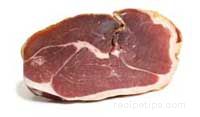 |
A ham from Parma, Italy that is dry-cured, aged for over a year and well known as a high quality distinctively flavored ham. The Parma ham is similar in appearance and taste to prosciutto, which has a delicately spiced and salty flavor. Parma ham is produced from a breed of pigs that are significantly larger in overall size than those raised in the U.S. and other countries for the production of hams. |
|
Prosciutto Ham
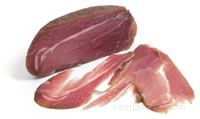
|
An Italian dry-cured ham that is cured with salt, sugar and spices for 9 months or longer, but is not smoked. Through part of the curing period the ham is weighted to create a dense, firm texture. This also gives it a flattened shape. In Italy, prosciutto crudo refers to raw ham and prosciutto cotto refers to cooked ham, but outside of Italy prosciutto is used in reference to raw ham. The best and most famous prosciutto is prosciutto di parma (or parma ham), which is made in Parma, Italy where the hogs are raised on parsnips and the whey left from making Parmesan cheese. Prosciutto has a delicate, salty flavor and should be cut into paper thin slices for serving. |
|
Schinkenspeck Ham
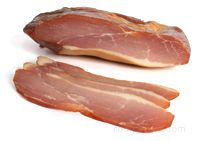
|
An original German product made from a lean cut of pork that is processed into a small slab of ham. It is dry-cured, aged and seasoned with juniper berries as well as other spices. Since Schinkenspeck is dry cured, it is ready to eat and can be served either hot or cold. In German, the term Schinken translated means ham and speck means bacon, which is a common use for this cut of meat. The shape of the cut makes it a natural size for bacon, as it can be sliced easily into long thick pieces for frying. When served cold, Schinkenspeck is prepared as thin slices of meat, similar to proscuitto, for use on dark and crusty breads with cheese or served as a meat to be made into an appetizer. |
Serrano Ham
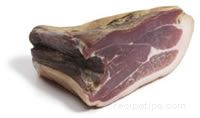 |
Serrano is a Spanish word meaning "mountain", which is the area that provides the ideal processing conditions for the Serrano ham. Cured in the cool, high altitude, this ham comes from the hind leg (jamon) and fore leg (paleta) of the hog. The meat has a coarse texture and is served thinly sliced for appetizers and sandwiches or as a complement to other foods. |
|
Westphalian Ham
|
A German ham that is made from hogs, which are fed acorns and raised in the Westphalia forest in Germany. The ham is dry cured and the smoked slowly over beechwood and juniper wood. The slow smoking process creates a dark golden pink, dense ham that has a mild smoky flavor. Westphalian ham is one of the best and is quite expensive. It is generally cut into thin slices and served raw. |
| York Ham |
A dry-cured, English ham that is smoked over oak sawdust. Generally it is lightly smoked but it can be found smoked a little more heavily. It must be cured within 2 miles of York to be considered a York ham. The ham is coarse and fairly salty, but has a mild flavor. It can be eaten raw but is often boiled in the same manner as a country ham. |
|
Specialty Hams
A variety of hams that have undergone special processes for curing, smoking, or cooking to produce a distinctive flavor. Specialty hams are generally dry-cured country hams aged for a long period of time (1 year or more) to develop a more intense flavor. Some specialty hams are brine cured, such as Irish ham, but most are dry cured. They are very expensive and most often have to be special ordered. Many specialty hams are imported from European countries. Many of these hams are produced from a particular breed of hog or hogs that are feed a special diet. Also, the type of wood used to smoke the ham contributes to its distinctive flavor. |
|
Black Forest Ham
(Brine Cured)
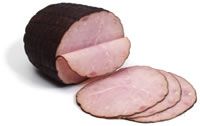
|
A specialty ham that has been brine cured and smoked to produce a unique flavor. This robust flavored ham may have the black exterior surface, which resembles the dry salt cured Black Forest ham, but it should not be mistaken for a true Black Forest ham. |
| Bradenham Ham |
An English ham that is first dry cured and then is cured in a mixture of molasses, brown sugar and spices. It is smoked and has a black skin. It has a sweet, intense flavor and deep red flesh. |
| Gammon |
Even though gammon comes from the hind leg, it is not considered a true ham because it is cured as part of one side of the pig or the whole pig. Once it is cured, the gammon (hind leg) is cut off the side or whole pig and sold as a separate cut. It has a mild flavor, is found smoked and unsmoked, and is more perishable than other hams. It is most often boiled when it is prepared. |
| Irish Ham |
A brine cured ham for which Belfast is famous. Irish hams develop a distinctive flavor of their own from being smoked over peat and/or juniper fires. The ham is prepared by soaking and cooking it in the same manner as a country ham. |
| Kentucky Ham

|
An American dry-cured country ham, which is made from the hind leg of a pig that has been raised on a diet of acorns, beans, clover, and grain. The ham has a delicate flavor and is slightly drier than Virginia ham. Kentucky hams are smoked over a fire of corn cobs, hickory wood, and apple wood. They are left to age for up to a year after they have been cured. |
|
Smithfield Ham |
Considered the best of the Virginia country hams. To be a Smithfield ham, it must be cured and processed in the Smithfield, Virginia city limits. The hams are slowly smoked over oak, hickory and applewood. They are generally aged for 6 to 12 months but some are aged up to 2 years. The entire process results in a dark colored, dry, and salty, but richly flavored ham. The ham can be eaten raw but is most often soaked to reduce the saltiness and then baked or boiled. |
|
Tasso Ham

|
Lean, highly seasoned pork that is served in the southern United States and most often associated with Cajun cuisine. It is made into a spicy ham, sometimes referred to as Cajun ham, having a peppery outer skin that has been heavily smoked. Tasso can also be produced as a beef product that has been cured and then smoked. Andouille, chorizo or linguica sausage can be used as substitutes that add more spicy intensity, but none of the three will provide the depth of the smoky flavor provided by tasso. Although very tasty, tasso may have a somewhat gristly texture. |
|
Virginia Ham
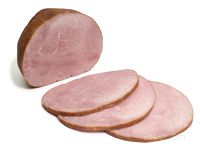 |
A group of country hams that are produced in Virginia. The hams are lean and are most often smoked over hickory and applewood. They were originally produced from pigs that were raised on a diet of peanuts and acorns. Today they are mostly grain fed. |
| Miscellaneous Hams and Ham Products |
|
Canned Ham

|
Ham that has been cured, had the bones removed, and then vacuum-sealed in a can with a small amount of dry gelatin. The ham is steam cooked in the can and the gelatin helps to absorb the natural juices of the ham. When opened, it is ready to eat or it can be heated before serving. Canned hams are not as flavorful and have a different texture than other hams but they offer convenience. They are available in two basic forms, shelf stable and refrigerated. Shelf stable canned hams can be stored for 2 to 5 years at room temperature but should not be stored at high temperatures (above 122° F). They are generally 3 lbs. or less in size. Refrigerated canned hams can be stored, unopened, in the refrigerator for 6 to 9 months. |
|
Canned Ham Chunks
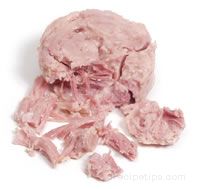
|
Chunks of ham that have been precooked and packaged in a can. The cans are tightly sealed to preserve freshness of the meat and the meat generally does not need refrigeration until the can has been opened. The canned ham can be used in recipes that call for chunks of ham. |
| Cottage Ham |
A cut from the top end of the shoulder, known as the shoulder butt, which has been cured in brine. A cottage ham is uncooked. Also referred to as a cottage roll. |
|
Deviled Ham

|
Ham meat or a mixture of ham and pork shoulder meat that is cured and then cooked with water, spices and other ingredients. The meat in some deviled ham is also smoked. After the meat and other ingredients are cooked, they are finely chopped into minced meat and packaged in a can and sealed. The spread generally is mixed with a combination of other ingredients, such as sour cream, cream cheese, mayonnaise, mustard, cheese, chopped vegetables, and spices. The spread mixture is used for sandwiches, spread on crackers as appetizers, or as a meat dip. |
|
Ham Patty
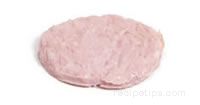
|
Coarsely ground ham or chunks of ham that have been pressed and formed into a round, flattened patty, which are generally prepared by baking, grilling, broiling or frying. They are available packaged as a canned product and as a frozen product. |
Honey Cured Ham
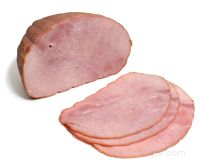 |
A ham that is wet cured with honey being at least ½ of the sweetening ingredient used in the curing mix. The honey must be used in an amount sufficient to affect the flavor and/or appearance of the finished ham product. |
|
Picnic Ham

|
This pork cut is not a true ham. It is a cut from the front shoulder of the hog, rather than the hind leg where the hams are found. It is smaller in size than a traditional ham and is cured in the same. It is not as tender as ham but it is a good substitute to use in recipes calling for chopped or diced ham and it is generally less expensive. |
|
Sugar Cured Ham
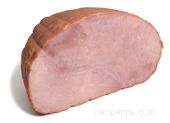
|
A ham that is wet or dry cured where sugar is at least ½ of the sweetening ingredient used in the curing mix. The sugar must be used in an amount sufficient to affect the flavor and/or appearance of the finished ham product. |
| Sweet-Pickle Cured Ham |
A ham that is wet cured in sweet seasoned brine. The sweetener and seasoning used in the curing process will vary according to the recipe of the producer. | |

